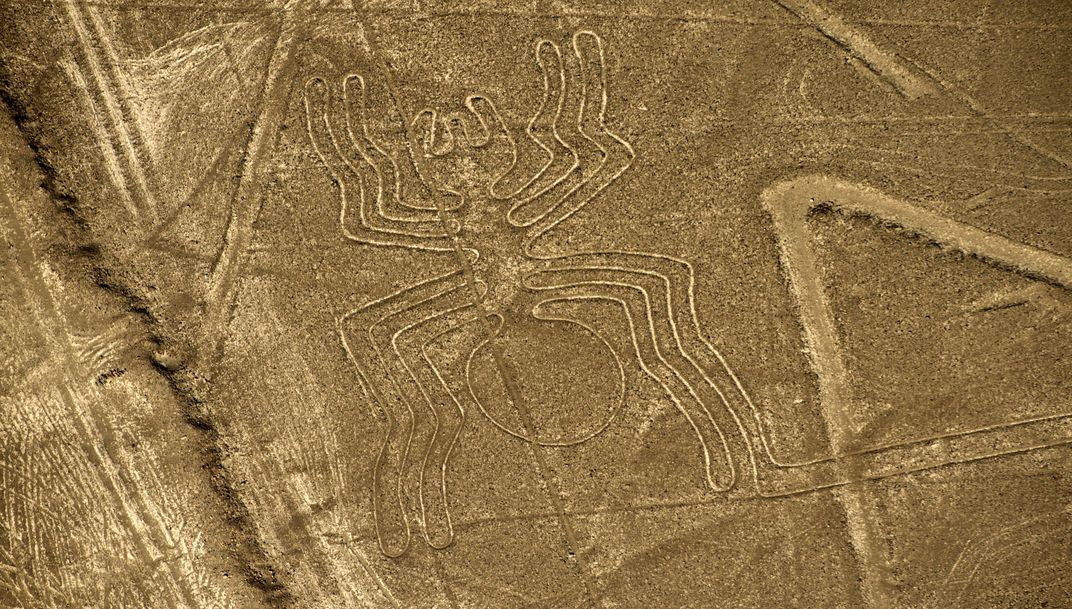Archaeologists Identify 143 New Nazca Lines
The trove of newly documented geoglyphs includes a humanoid figure identified by artificial intelligence
/https://tf-cmsv2-smithsonianmag-media.s3.amazonaws.com/filer/37/7c/377cbce3-43ee-44b3-956b-c918cecfa11d/nazca_humanoid.jpg)
Peru’s Nazca Lines—a series of huge geoglyphs etched into a coastal plain in the country’s southern desert—have mystified archaeologists since they were first spotted nearly a century ago. The roughly 200-square-mile stretch of land is known for its carvings of geometric shapes, birds, monkeys and humanoid figures.
Thanks to a new analysis conducted by an international group of researchers, scientists now have even more glyphs to marvel at: As a press release from Japan’s Yamagata University states, the team has uncovered 143 previously unseen etchings—including the first Nazca Line identified using artificial intelligence.
According to the statement, archaeologists led by Yamagata University’s Masato Sakai have been studying the Nazca Lines, created between 200 B.C. and 500 A.D. by members of the Nazca culture, since 2004. Initially, the researchers analyzed the area largely through satellite imagery, but as of 2010, the team has also spent time in the field studying the strange desert markings. This fieldwork led to the discovery of the new Nazca lines, which feature 40 biomorphic glyphs depicting animals, plants or people.
Per Iliana Magra of the New York Times, Sakai and his colleagues collaborated with IBM to teach an artificial intelligence system named Watson to find glyphs overlooked by humans. The team trained the A.I.’s neural network with images of previously identified carvings.
Finding the new glyph proved difficult even with Watson’s help. As Akihisa Sakurai, a researcher with IBM Japan, tells the Verge’s James Vincent, researchers have identified fewer than 100 biomorphic geoglyphs at the site to date; each is fairly unique, making it difficult to teach A.I. what to look for when tracking down hidden shapes.
Sakurai says, “We specifically built techniques in the deep learning framework to learn and distinguish between these different patterns and sizes of the geoglyphs.”

Watson ended up finding more than 500 potential glyphs, reports Science News’ Maria Temming, but according to the release, the A.I. only found “several possible” biomorphic ones. The team chose one of these candidates and conducted an on-the-ground investigation during its 2019 field season. Impressively, the A.I.’s suggestion proved accurate: Archaeologists uncovered a previously unknown humanoid figure measuring around 13 feet tall and 6.5 feet wide.
“It is in an area that we often investigated, but we did not know the geoglyph existed,” Sakai tells the Verge. “It’s a large achievement.”
The etching almost resembles a contemporary cartoon character or mascot. Its subject stands on two legs, wears a hat of sorts represented by three lines rising above its vaguely television-shaped head, and wields a club or stick in its right hand.
In hopes of building on this discovery, the university will continue collaborating with IBM in its search for new Nazca Lines. According to an IBM press release, Sakai and his team plan on using the tech giant’s PAIRS Geoscope platform to integrate 10 years of drone and satellite imagery with geographical survey data.
Magra reports that Sakai hopes to use this new technology to map out and protect the etchings researchers already know exist. In his words, the Nazca Lines—declared a Unesco World Heritage site in 1994—are “facing a crisis of destruction.”
“The most important point is not the discovery itself,” says Sakai. “… They should be cleaned up. If they become clearly visible, they will be protected as important cultural heritages.”
Last year, a truck driver zooming along the Pan-American Highway veered off the road, leaving tire tracks on three of the ancient glyphs. And in 2009, unprecedented rainfall flowing off the highway damaged three fingers on a hand-shaped glyph. The Nazca Lines are also at risk of mining and illegal agriculture, including pig farmers squatting on the protected land.
Exactly why the lines were carved into the surface of the Peruvian desert remains unknown. Some researchers suspect the geoglyphs may have been associated with astrology, while others link the giant etchings to rituals designed to encourage rainfall and fertility. Additional A.I. analysis may shed more light on the heritage site’s original purpose.
“By gaining a detailed understanding on where the figures are located and when they were used,” the press release states, “researchers aim to attain a closer look into the worldview of the people who made and used these geoglyphs.”